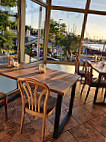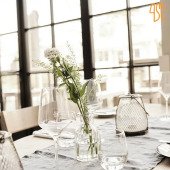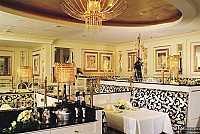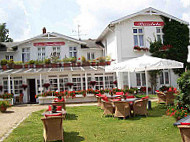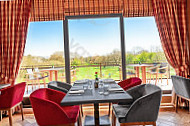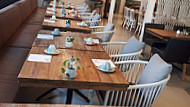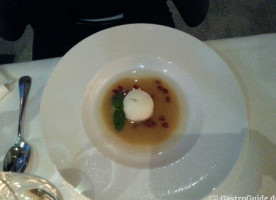"Es ergab sich einmal wieder eine gute Gelegenheit, um die Landschaft der gastronomischen Spitze im Lübecker und Ostholsteiner Raum zu erkunden, welche ich natürlich in keinem Fall auslassen wollte. Nach einem familiären Ausflug zu den bekannten Karl-May-Festspielen in Bad Segeberg sollte der Abend erneut eine kulinarische Krönung erhalten. Unsere Wahl führte uns dabei wieder in das direkt an der Lübecker Bucht gelegene Timmendorfer Strand, welches ich ja bereits für den sehr positiv überraschenden Besuch des Balthazar im Mai dieses Jahres aufgesucht hatte. Wie kürzlich vermeldet, musste das Balthazar zwischenzeitlich, sehr zu meinem Bedauern, seine Pforten hingegen schließen. Zum Glück stand und steht es mit seiner Michelin-Auszeichnung aber keineswegs allein in diesem St(r)and-Ort da. Bedeutet die hier in den beiden wichtigen Bereichen der Gastronomie seit fast 3 Jahrzehnten gelebte Konstanz durch Küchenchef Lutz Niemann und Chef-Maitre und -Sommelier Ralf Brönner nun eine durch viel Erfahrung makellos vorgebrachte Routine des Glücklichmachens , oder zeigt sich schon eher eine weniger ansprechende Staubschicht auf der langen Tradition? Dies zu erfahren steigerte die Spannung und Vorfreude auf diesen Abend, gerade im direkten Vergleich mit der tollen Erfahrung im Balthazar , welche ja nun leider unwiederholbar im Gedächtnis bleiben muss. Hinsichtlich des Ambientes ist es sicherlich auch wenig überraschend, dass man in der Orangerie weder auf eine futuristisch-topaktuelle, noch auf eine leger-urbane Ausstattung trifft. Im Maritim Seehotel -Hochhaus befindet sich das gastronomische Aushängeschild gleich im Erdgeschoss, zwar nicht mit Blick auf das Meer, aber trotzdem die schöne Begrünung des Platzes vor der Hinterseite des Hotels. Hier befindet sich auch eine Art Veranda-Wintergarten, der den Gästen ihr Mahl mit frischer Seeluft um die Nase, aber dabei doch in witterungsgeschützter Lage, ermöglicht. Man wäre schon fast enttäuscht gewesen, wenn das Interieur eines solchen Traditions-Restaurants der gehobenen Gastronomie nicht mit einem üppigen Kronleuchter aufwarten würde. Natürlich wird dieser Erwartung bereits beim Betreten der Räumlichkeit gerecht, in dessen Zentrum ein ebenjenes Licht-Ensemble sofort ins Auge sticht. Auch auf Augen-Ebene ist die Ausleuchtung mit Krönchen -bestückten Lampen gestaltet und Spiegel an den Wänden verstärken deren Wirkung. In Verbindung mit der durchweg hellen Creme-Farbgebung von Vorhängen und Sitzbezügen ergibt sich somit eine aufhellende Atmosphäre, in der aber auch das natürliche Tageslicht nicht zu kurz kommt. Schlüssig wirken da die schwarzen Ornament-Verzierungen auf den Stoffbezügen und der ebenfalls ornanementierte schwarze Teppichboden als farblicher Kontrast, die dem Interieur Schwung und Eleganz geben. Etwa 60 Plätze gewährt der Innenbereich, in dem die Tische mit hüfthohen Trennwänden eine sehr private Atmosphäre gewähren. Weiße Tischdecken fehlen in dieser Gestaltung natürlich ebenfalls nicht. Vereinzelte Blumengestecke fügen dem Interieur noch kleine Farbkleckse hinzu. Für besondere Anlässe listet das Restaurant auch Private Dining Rooms auf seiner Webpräsenz auf. Ein erfreuliches Zeugnis dafür, dass man sich hier gerne auch neueren Konzepten der Gegenwart im wahrsten Sinne des Wortes öffnet ist die Tatsache, dass eine offene Küche an der Stirnseite des Gastraums solch an der Kochkunst interessierten Gästen, wie mir, die Möglichkeit gibt, dem Treiben des eingespielten Teams um Lutz Niemann direkt zuschauen zu können. Das Restaurant war an diesem Samstag-Abend zu schätzungsweise 80 ausgelastet. Um diese beträchtliche Anzahl an Gästen kümmerte sich eine 3-köpfige Service-Brigade, in der natürlich auch der bereits erwähnte Ralf Brönner, sowie ein junger Mann und zwei junge Damen voll aktiv waren. Dem klassischen Ambiente passte sich Herr Brönner als „Chef-Gastgeber“ mit ebenso klassischem Anzug an, während die weiteren Servicekräfte legerer in gebügeltes weißen Hemd mit rotem Service-Schurz die Atmosphäre nochmals passend auflockerten. Wir kamen während des Abends mit allen Gastgebern in Kontakt, während die hauptsächliche Kommunikation mit dem jungen Service-Herrn stattfand. Er zeichnete sich durch gekonnte Freundlichkeit. Leider kam er aber, im Gegensatz zu den ersten Gängen des Menüs, gerade bei der Käseauswahl und der Präsentation der Petit Fours ins Schwimmen. Nicht nur, dass er mir z.B. die Käsesorten nicht erläutern konnte, am Ende musste ich mir den auf den benachbarten Tisch gestellten Teller mit meiner Auswahl auch selber an den Platz holen, da er diesen in seiner Aufgeregtheit wohl komplett vergas. Wie auch bei den Petit Fours fiel ihm dabei zudem häufig das Besteck herunter bzw. die Petit Fours von deren Platten. Leider doch nicht unbeachtliche Fehltritte im Angesichts des Anspruchs des Etablissements, die man leider doch nicht unter den Teppich kehren kann. Die jungen Damen machten ihren Job am Tisch mit Routine und Genauigkeit. Auch Herr Brönner war beim Servieren und Annoncieren bei uns nicht aktiv, wünscht aber gerne zB vor dem Hauptgang extra noch einmal guten Appetit und schenkte uns Wasser nach. Zu dem Käse- und Petit-Fours-Fauxpas kam zudem noch eine arg lange Pause zum Hauptgang, bei der wir uns ein wenig vergessen fühlten. So passte sich die Serviceleistung dem edlen, klassischen Ambiente also in seiner Art und Weise schon an, lässt sich aber aus den genannten Gründen leider nicht mit höchster Punktzahl bewerten. Es sei aber betont, dass die Stimmung darunter nicht im Übermaß litt. Nun aber endlich zum kulinarischen Teil. Ein 6-Gang-Menü namens Orangerie Menü für 139 € kann auf Varianten in 3 Gängen für 89 €; 4 Gängen für 106 € und 5 Gängen für 124 € reduziert werden. Zudem wird parallel noch ein a-la-carte Angebot gewährt, was heutzutage immer seltener in Gourmetrestaurants anzutreffen ist. Deren preislicher Umfang reicht bei den Vorspeisen und Desserts in den Bereich der 20er und 30er und bei den Hauptgängen in den 50er und 60er €-Bereich. Die offerierten Speisen spiegelten schon von Namen und Zusammenstellung her die klassische Basis der hier gelebten Kulinarik wider. Aktuell standen dabei z.B. Produkte wie Pfifferlinge, Seezunge oder Rehbockrücken im Fokus, wobei auch die Hervorhebung verschiedenster Saucen wie z.B. Sauce Mousseline und Brombeerjus den klassischen Küchenpfad markierten. Klassisch mit phantasievollen Akzenten und unverfälscht und köstlich : diese zwei Zitate von der Restaurant-Website fassen den eigenen Anspruch an die gebotene Kochkunst wohl am besten zusammen. Aus diesem erläuterten Angebot entschieden ich mich dazu, das „Orangerie Menü“ in 4-Gängen zu verköstigen, während sich meine Begleitung in 3 Gängen vom kulinarischen Credo der Orangerie-Küche überzeugen wollte. Aus den 6 Gängen hat man dabei übrigens komplette Kombinationsfreiheit. Bei den Getränken beließ ich persönlich es wie gewohnt beim stillen Wasser, welches hier von der Marke Gerolsteiner Gourmet naturell stammte und 8,5 € pro 0,75 l Flasche kostete. Meine Begleitung genoss zudem noch Roséwein von Andreas Bender für 8,5 € das 0,2 l Glas. Den kulinarischen Auftakt bildete als Apero ein Lachs-Tatar mit Meerrettich, Apfel-Scheiben und Apfel-Baiser Das Tatar erfreute den Gaumen bereits mit wunderbarem Schmelz. Auch der Apfel war aromatisch schön präsent und fügt auch etwas Knackiges hinzu. Lediglich der Meerrettich war nicht zu spüren und fehlte somit auch als willkommener Gegenpol, sodass der Appetizer insgesamt etwas zu süß wirkte. Gegen den akuten Hunger konnte man im Folgenden mit einer tollen Brot-Arrangement gegensteuern. Das Sauerteigbrot war wunderbar, sogar innen noch dampfend, gewärmt und erfreute mit krosser Kruste und locker-leichter Krume. Ein Leinsamen-Knäckebrot eignete sich als knusprige Basis um einige der weiteren Beigaben zu diesem Brot-Arrangement zu verköstigen. Diesen waren z.B. eine Nussbutter (unten), die leicht wie ein Schaum und gleichzeitig trotzdem charakteristisch süßlich-aromatisch daherkam. Eine Kichererbsencreme (rechts) war ebenfalls sehr locker und cremig und somit eine leichte Hummus-Interpretation mit getroffen eingesetzter Säure. Auch das Olivenöl war von besonders einprägender Qualität mit toller Fruchtigkeit. Karamellisierte Kürbiskerne (links) rundeten das Arrangement als schön süß-salzige Knabberfreude genauso ab wie das obligatorische Fleur de Sel (rechts direkt unter dem Brot). Ein weiteres Amuse Gueule schloss die Einstimmung vor dem Menü mit einer Variation rund um den Thunfisch ab. Dies bestand einerseits aus einem Thunfisch-Mosaik mit Nori-Alge. Der rohe Thunfisch zeigte eine wirklich sehr gute Sushi-Qualität und zeichnete sich durch seine fleischige Konsistenz und schön frischen Geschmack aus. Beim Thunfisch-Tatar mit Zucchini und Shisokresse-Sorbet überzeugte natürlich der Thun erneut mit diesmal leicht cremiger, frischer Qualität. Dieser schmelzigen Textur lieferten die ganz fein und sehr exakt geschnittenen Zucchini-Scheiben mit ihrem Biss eine passende Mundgefühlsebene hinzu. Das darauf thronende Shisokresse-Sorbet belebte das Türmchen schließlich, was beim Lachs-Apero mit dem Meerrettich für mich noch gefehlt hatte, mit einer schönen Balance aus Süße und Schärfe Eine dazu gereichte Scheibe vom roten Rettich gab dem Amuse mit seiner Schärfe noch einmal einen kleinen aufblitzenden Kick, der die Geschmacksknospen animiert. Die Gel-Tupfer haben hingegen keinen geschmacklichen Mehrwert. Nach diesem Appetitanregenden Einklang startete das Menü für mich mit der ersten Vorspeise, die sich Périgord Gänseleber mit Mirabelle, Apfel und Mandel widmete. In gleich drei Variationen wurden die annoncierten Hauptakteure dabei in Szene gesetzt. Die Gänseleber-Pastete im Mandel-Mantel (unten) begeisterte mich mit handwerklich und qualitativ perfekter Ausarbeitung dank schnittfester Konsistenz und trotzdem herrlichem Schmelz, dem die Mandeln natürlich eine passend knusprige Komponente anbei gaben. Ein Gänseleber-Creme mit Apfel-Kern und Waldbeer-Gelee-Ummantelung (links) überzeugte, wie fast nicht anders zu erwarten überzeugte, mit lockerer Luftigkeit. Während der Apfel dabei kaum ertönen konnte, übernahm das Waldbeer-Gelee diesen begleiteten Job hingegen perfekt, denn Säure und Süße passten wunderbar zur herben Herzhaftigkeit der Leber. Mein aber das noch toppender Favorit war die karamellisierte Gänseleber auf Apfel-Mirabellen-Kompott (oben). Oben Knusprig gebraten und mit leicht-rosa herrlich saftigem Kern wurde die handwerkliche Können in der Küche erneut klar bewiesen. Zudem gab sie als warme Komponente eine tolle Temperatur-Abwechslung zu den beiden anderen, kalten Leber-Kompositionen. In Sachen Präzision machte auch die Unterlage aus super-feinem Mirepoix aus Apfel und Mirabelle das Niveau deutlich. Zu dieser erneut erfreulich knackigen Abwechslung kam auch hier wieder ein schönes süß-sauer Spiel als Begleiter zur Leber hinzu. Weitere kleine Elemente auf diesem vielseitigen Teller waren eine Marzipanhippe und Tupfer von Mandel-Marzipan-Creme, Mirabellen-Gelee und kleine Mirabellen-Abschnitte. Sowohl die Marzipanhippe als auch Cremetupfen von Mandel-Marzipan waren viel mehr aromatisch als nur süß und passten damit sehr gut in das gesamte Konzept des Gerichts. Gerade die kleinen Mirabellenschnitte und -Geleetupfen gaben mit einer abermals pointierten Säure eine weitere Frische dazu, die der herben Leber ein passendes Gegengewicht gab und somit einen runden Gesamtgeschmack erzeugt. Eine für mich phänomenaler Auftakt, den ich wahrlich als „zum Augenschliessen gut“ bezeichnen möchte. -Bild Brioche A part durfte die bekannte angetoastete Scheibe Brioche selbstverständlich nicht fehlen. Im für mich zweiten Gang begann dann auch das 3-Gang-Menü meiner Begleitung, womit uns beiden nun Hummer und gebackene Fördegarnele mit Ananas Chutney und Bisque serviert wurde. Die ausgelösten Stücke vom Schwanz und der Schere zeigten erneut, dass hier eine sehr gute Produktqualität an erster Stelle steht, denn Fleischigkeit und Saftigkeit waren genauso, wie man sich es von diesem Meeresbewohner wünscht. Der Hummer badetete dabei in einer Krustentier-Bisque, welche schon beim Angießen die Nase betörte und dankenswerterweise auch in einer Sauciere zum Nachgießen am Platz verblieb. Kein Tropfen sollte davon übrig bleibe, denn auch ihre geschmackliche Kraft überzeugte auf jedem Löffel. Dazu lieferte frischer grüner Spargel eine vegetabile Knackigkeit und seinen charakteristischen Geschmack hinzu. Die anscheinend im Pankomantel ausgebackene Fördegarnele war von stattlicher Größe und lieferte mit ihrem herzhaften Crunch eine Spaßmachende Abwechslung zu Hummer und Bisque. A part wurde auf einem Ananas-Chutney ein cremiges Hummer-Tartar gereicht bei dem die ausgefeilte Säure der Ananas eine weitere Kombinationsebene mit dem edlen Meerestier addierte. Für den Hauptgang entschieden wir uns beide für die Fisch-Variante, welche neben einem Gang um Salzwiesen-Lamm zur Wahl stand. „Atlantik Steinbutt mit Pfifferlingen, Gartengurke, Dill und Kartoffel kam darum nun für uns auf den Tisch. Und hier erwartete uns beide noch einmal perfektionierte Klassik in Reinform. Das Filet vom Steinbutt war nicht nur trefflich saftig und in seine Lamellen leicht zerteilbar, sondern durch den Bratvorgang auch auf den Punkt geschmacklich veredelt. Nocken eines ganz feinen, buttrigen Kartoffelpürees umschmiegten den Hauptakteur perfekt, wobei der Dreiklang aus Pfifferlingen, ausgestanzten Gurkenscheiben und frischem Dill geschmacklich ebenfalls klar und in optimaler Balance hervorkam. Was darf zum völligen Abschluss eines solchen klassischen Fischgangs dann nicht fehlen? Natürlich eine schaumige Beurre blanc, die auch hier das gemeisterte Kochhandwerk abermals bewies und mit salzig-säuerlicher Ausgewogenheit auch geschmacklich optimal gelungen war. Auch hier erfreuten wir uns über die zum Nachschenken am Platz verbliebene Sauciere, die vom Service absolut leer abgeräumt werden konnte Klassischerweise durfte natürlich auch im Menü der „Orangerie“ ein Predessert zum Übergang in den abschließenden Menüteil nicht fehlen. Ein Himbeersorbet thronte auf einer in einem Quader aus knackiger, weißer Schokolade befindlichen Himbeer-Buttercreme. Dieser saß auf etwas Himbeer-Gelee und wurde mit Champagner-Schaum und einer Baiser-Scheibe getoppt. Zusammen mit den Himbeerstücken war dieses Produkt hier erneut mit Texturen und Temperaturen schön herausgearbeitet. Die schöne Säuerlichkeit wurde dabei nicht vernachlässigt, insgesamt war es für meinen eigenen Gaumen aber als Predessert doch etwas zu prononciert süß. Geschmacklich und handwerklich gab es aber erneut wirklich nichts auszusetzen. Für den Abschluss des Menüs gewährte man, für mich persönlich erfreulicherweise, ebenfalls sowohl eine gewohnt süße aber auch eine herzhafte Möglichkeit. Wie angesichts der schon so häufig erwähnten Klassik der kulinarischen Philosophie des Hauses zu erwarten, bestand Letztgenannte natürlich aus einer Rohmilchkäse-Auswahl. Auf Grund der oben erwähnten Service-Fauxpas kann ich zu den von mir gewählten Sorten leider gar nichts sagen, denn das konnte schon der präsentierende Serviceherr leider nicht. Dank Herrn Brönner ließ sich wenigstens noch erfahren, dass diese vom Bekannten Hof Backensholz stammen, der mich in manchen Restaurants auch schon über den Weg lief. Ich wählte dann also einen Blauschimmelkäse (unten), sowie eine etwas weichere, geschmacklich klar als Ziegenkäse identifizierbare Variante (links). Dazu kamen noch zwei Hartkäse, von denen einer an einen Deichkäse (oben) und der andere an eine Art Parmesan (rechts) erinnerte. Auch wenn ich wie gesagt über die genaue Basis der Sorten nichts weiß, waren sie doch alle von sehr guter Reife und Aroma. Auch die klassische Begleitung mit Pumpernickel, Früchtebrot, Honig, Butter, Trauben und den mir besonders gefallenen schwarzen Walnüssen ließen schöne Kombinationen zusammenstellen. Mein Gegenüber wollte selbstverständlich nicht auf die Befriedigung ihres süßen Zahns verzichten. Zweifellos wollte sie sich deshalb an dem nun servierten Dessert namens Feines von Schattenmorellen und Herzkirschen mit Aromen von Balsamico erfreuen. Wie schon beim Predessert war auch hier die Kirsche in vielfältiger Art und Weise schön ausgearbeitet, sei es als Sorbet, Baiser oder den überraschenden „falschen“ Kirschen aus einer Art Kirsch-Creme im Gelee-Gewand. Im zentralen Kirsch-Spiegel, der in einem schönen Karamellcreme-Ring lag, wurde zudem der Balsamico eingearbeitet, der für meine Begleitung auch trefflich und merklich hervorkam. Mit ihrem Dessert war sie also rundum glücklich. Dank der abschließenden, kleinen Staffel an Petit Fours musste auch ich auf den letzten Insulin-Shot nicht verzichten, wobei auch hier etwas negativ erwähnenswert ist, dass auf dem Teller für beide Personen nur jeweils ein Exemplar servierte wollte, was auf Nachfrage auch so beabsichtigt ist. Nach eigenem Gusto konnte sich dann aber jeder von uns noch etwas vom Pralinenwagen für sich selber auswählen. —— Bild Pralinenwagen Ohne, dass ich die große Auswahl genauer erläutern kann, überzeugten doch auch hier Handwerk und Geschmack durchweg und schlossen die Speisen für uns perfekt ab. Wie gewohnt möchte ich also die gesammelten Eindrücke von diesem Samstag-Abend-Menü in der Orangerie zusammenfassen. Die gelebte Klassik von nunmehr 28 Jahren Sterne-prämierter Gastronomie wird dem Gast schon beim Betreten des Gastraumes gewahr. Dieses Ambiente war dabei aber nicht verstaubt oder altmodisch, sondern präsentierte sich sehr edel und gemütlich zugleich. Eine erdrückende Schwere von antiquiertem Luxus war definitiv nicht zu vernehmen. Im Grund agierte auch das Service-Team um Ralf Brönner in einer Art und Weise, die den Attributen dieses Ambientes trefflich angepasst war. Wie beschrieben lassen sich, gerade im Vergleich zu anderen gehobenen Restaurants, die ich bisher besuchen konnte, die doch klaren Mängel in Sachen Wissen um die gebotene Käseauswahl und die wohl aus Aufregung resultierenden Servier-Fauxpas gegen Ende es Menüs aber in der abschließenden Bewertung nicht ignorieren. Trotzdem möchte ich abermals betonen, dass das den Gesamtgenuss, den wir von diesem Abend mitnahmen, nicht nachhaltig schmälerte, aber im Fazit eben doch nicht unerwähnt bleiben kann. Demgegenüber schaffte es das Team um Lutz Niemann in der Küche mit dem gebotenen Menü von vorn bis hinten nicht zur zu überzeugen, sondern auch zu begeistern. Eines war für mich bei allen Speisen dabei ebenso auffällig wie erfreuend gefällig. Deutlich stützte sich die Aromatik der Gerichte stets auf den reinen Geschmack seiner Produkte. Gewürze spielten hier nie eine Rolle und waren auch komplett unnötig, denn aus jeder Komponente hat man stets das Beste und viel Intensität herausgeholt. Das verdeutlicht noch einmal ganz stark die Erfahrung, die hier in der Küche steckt, sowie die Wertschätzung und Beherrschung handwerklicher Perfektion. Eine Küche, die diese Lobeshymnen auf ihre gelebte Kunst für mich absolut verdient hat. Das konnte ich glücklicherweise Herrn Niemann gegen Ende unseres Menüs in einem interessierten persönlichen Gespräch bei seinem Besuch am Tisch auch gleich vor Ort übergingen, wobei er mir seinen Fokus auf die eigene Kraft der Produkte und der damit verbundenen, klassischen Geschmacksbilder bestätigte. Gleichwohl versucht er, auch durch einen intensiven Austausch und Mitarbeit seiner jungen Köche stets den aktuellen Gang der Zeit nicht aus den Augen zu verlieren, was ihm auch für mich sehr gute gelungen ist. So ergibt sich in Retrospektive des an diesem Abend gewährten Genusses eine Rechtfertigung des verlangten Preises, welcher mit einem rundum entspannten und wohlschmeckenden Abend eine weitere tolle Erinnerung und Erfahrung im gastronomischen Tagebuch ermöglichte. Das machten auch die erwähnten Abstriche beim Service nicht zunichte."
 Timmendorfer Strand
Timmendorfer Strand
